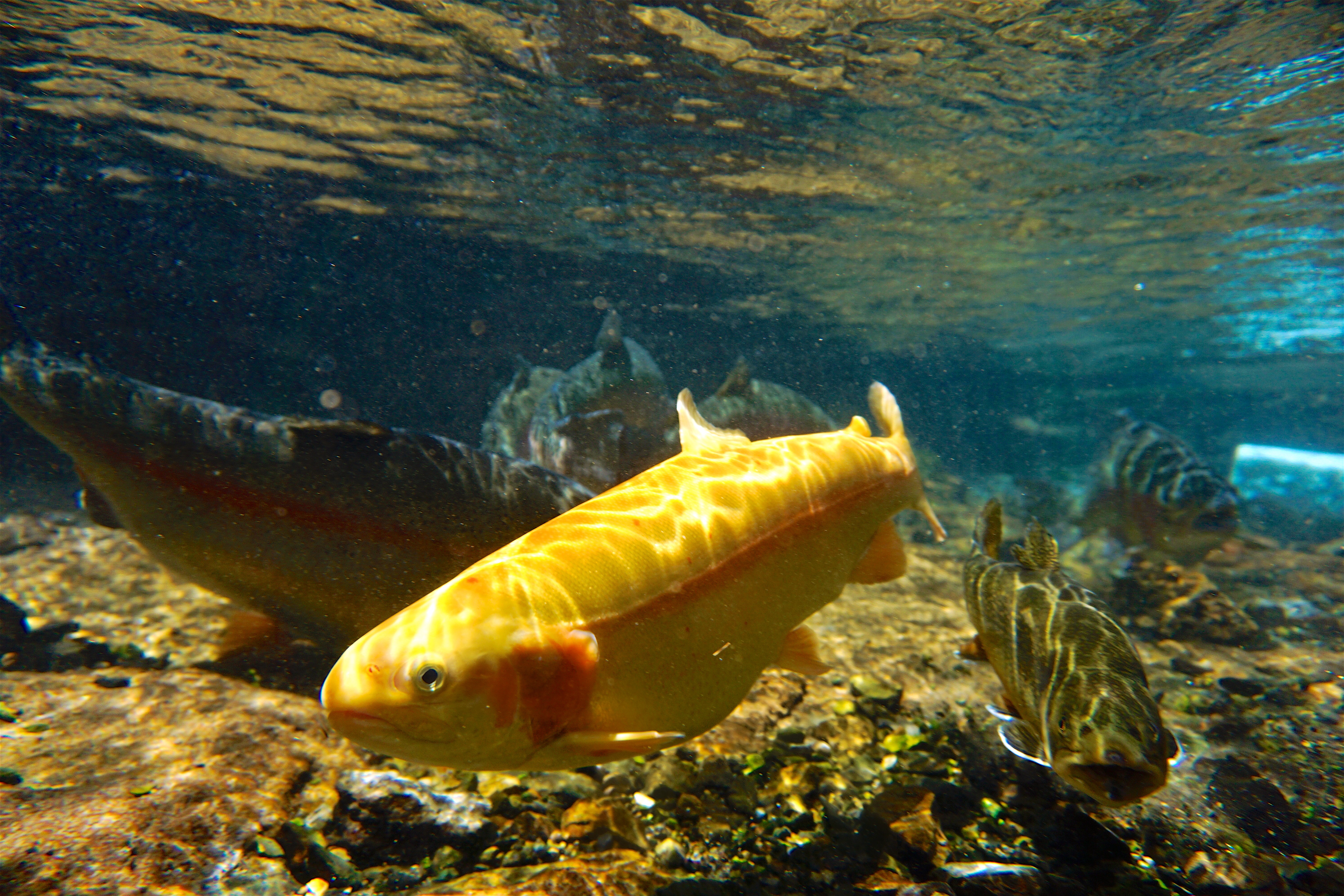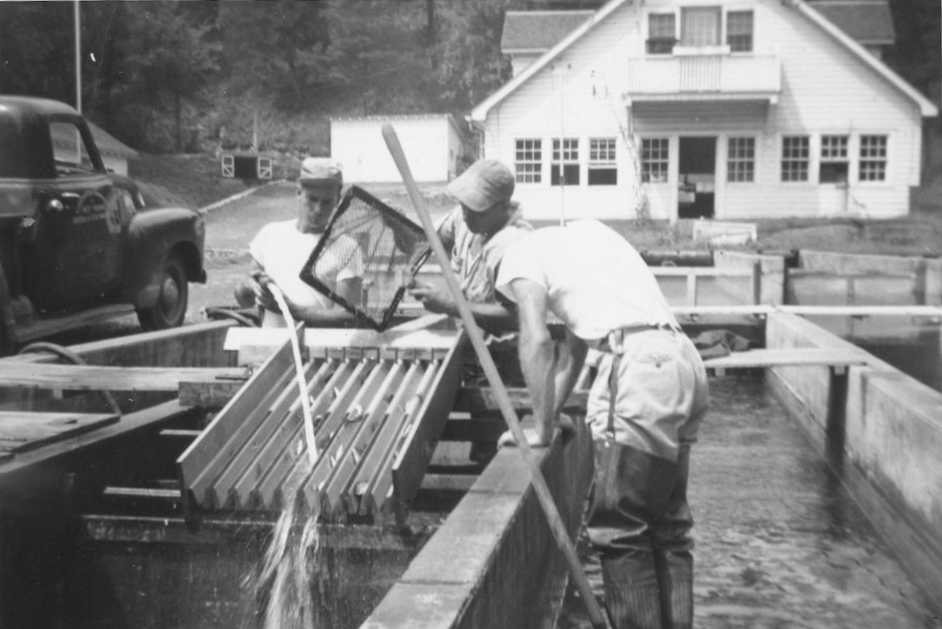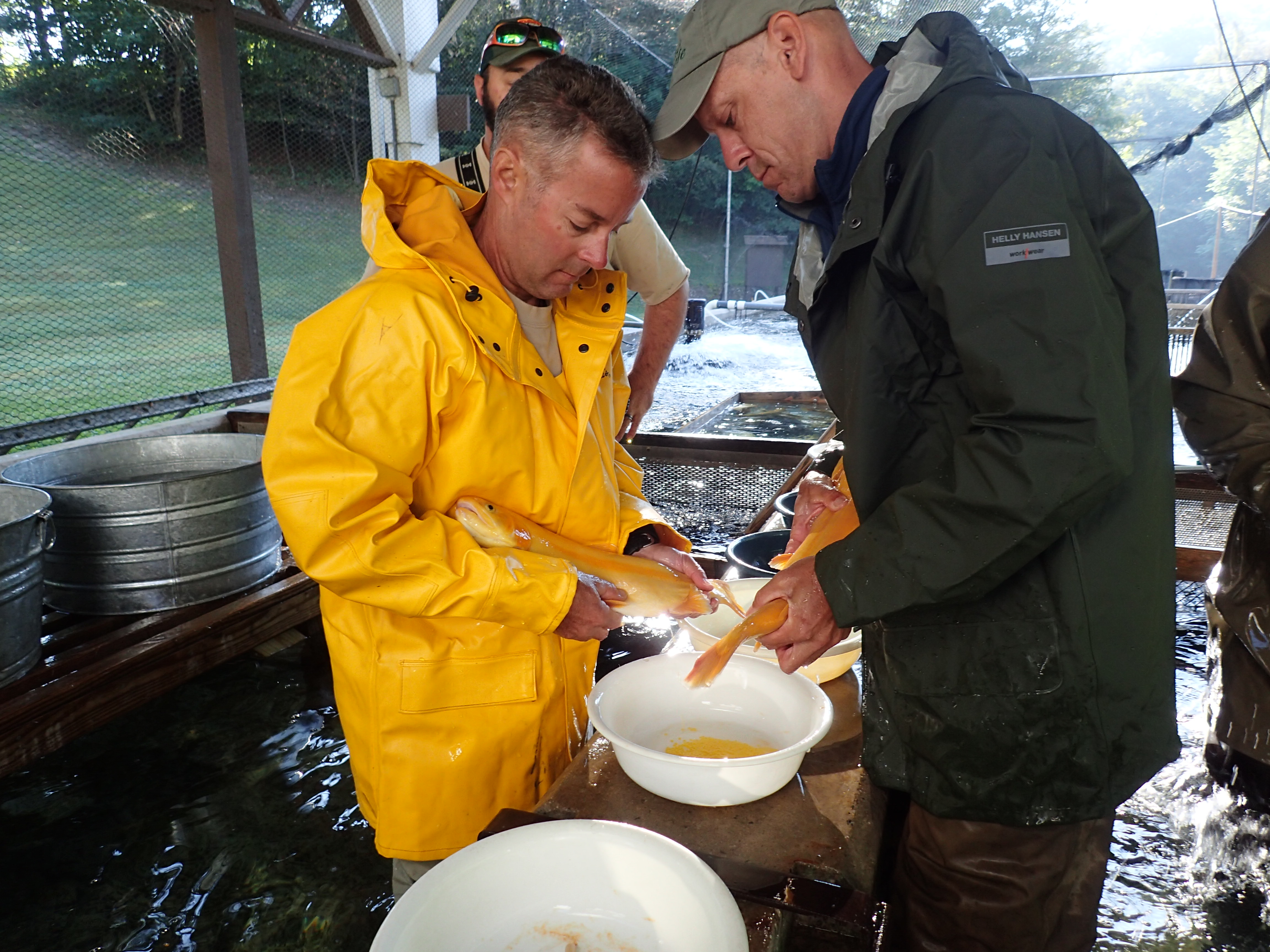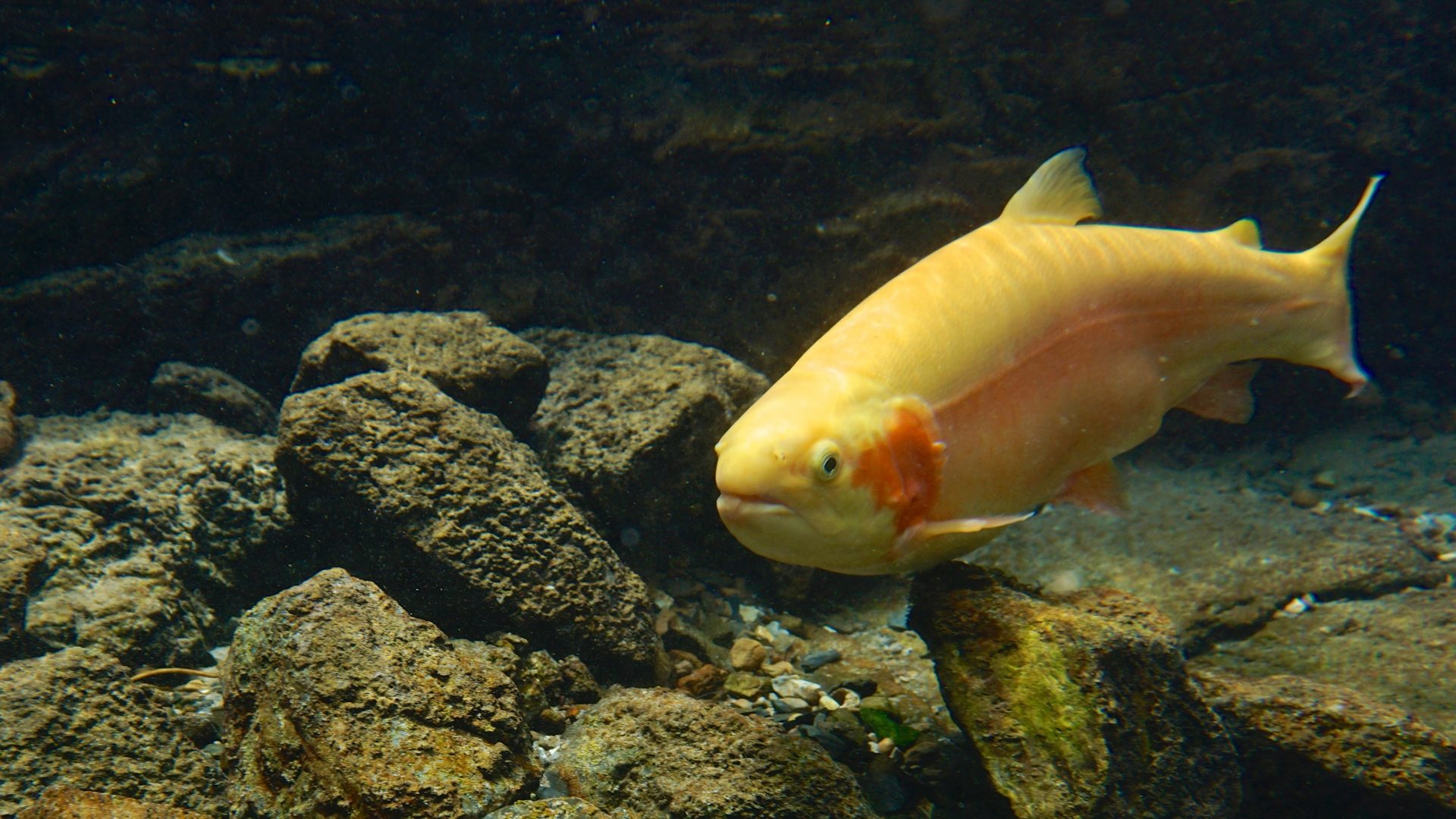The golden rainbow trout is one of the most treasured fish in West Virginia, and is prized by anglers young and old for its unmistakable, bright-yellow color. For more than 50 years, these freshwater cousins of the rainbow trout (Oncorhynchus mykiss) have provided a special experience for anglers who have been lucky enough to catch them and a source of frustration for those who haven’t.
Like gold panned from a mountain stream in the old west, catching a golden rainbow trout requires patience and skill. Getting a golden rainbow trout to bite is difficult, but when they do take the bait you’ll be able to say you found gold in the hills of West Virginia.

West Virginia’s golden rainbow trout gets its iconic color from years of selective breeding.
History of the Golden Rainbow Trout
While this fish is commonly called the golden trout in West Virginia, it is more properly named the golden rainbow trout. That’s because these fish are in fact a mutated strain of the rainbow trout, and have been selectively and successfully bred by West Virginia Division of Natural Resources biologists. Despite being golden in color, West Virginia’s golden rainbow trout are not related to the California golden trout (Oncorhynchus mykiss aguabonita), which is a subspecies of rainbow trout found high up in the streams of the Sierra Nevada. Introduced to the public in 1963 as part of West Virginia’s centennial celebration, the golden rainbow trout took several years to develop. In the fall of 1949, the Petersburg State Trout Hatchery in Grant County received 10,000 rainbow trout fry from a California strain as a gift from the White Sulphur Springs Federal Hatchery. Less than 300 survived, but those fish were bred over the years to create a brood stock that went on to produce a single embryo that started the golden strain.
In early 1955, sharp-eyed Petersburg Trout Hatchery Manager Vincent Evans noticed a yellow-mottled fingerling swimming among thousands of other trout fry. Evans named the juvenile fish “Little Camouflage” and moved it to a separate rearing pond. Later that year, Evans transferred to the Spring Run Hatchery and Chester Mace took over at Petersburg. Mace and his assistant, David Cochran, took special interest in Little Camouflage. By mid-summer of 1956, the fish had grown to 14 inches and its spotted coloring turned into a wide band of golden scales. Mace and Cochran determined the fish was female, a revelation that opened some interesting possibilities.
In October 1956, 900 eggs from Little Camouflage were fertilized with milt from a regular rainbow trout male. When the eggs hatched at Petersburg, the small fry grew into fingerlings, but none showed a trace of their mother’s golden color. That winter, the fingerlings were sent along with 500,000 other fish to the rearing ponds at Spring Run. In February 1957, attendants noticed that several of the small fish were turning a pale-yellow color. Within a few weeks, nearly 300 became golden in color.

DNR biologists grade fish at the Petersburg Hatchery in September 1954.
A Golden Experiment
As the fish got older, they also got “golder.” In 1957, DNR’s fish division chief Dr. Edward C. Kinney and his staff conducted spawning experiments to produce trout with the desired color. Within two years, more than 90 percent of the eggs hatched showed golden coloring. Although the first fish in this experiment were small, additional selective breeding brought future broods up to the size and vigor of regular rainbow trout. With their success, game fish specialists knew they had something that would be of interest to the state’s anglers and attract visitors to fish in West Virginia.
The Golden Age: 1863
After years of breeding, it was time to introduce the new golden rainbow trout to the public. After some experimental stockings in 1962, DNR biologists decided West Virginia’s centennial in 1963 would be the appropriate time to properly release the golden rainbow trout by including them in regular rainbow trout stockings across the state. One golden rainbow trout was stocked for every 10 regular rainbows, a ratio maintained to this day. The new fish were officially dubbed “The Centennial Golden Trout,” and they bore two tags: a yellow one anglers could keep as a souvenir and an orange one they could submit for a chance to win a prize.

DNR biologists fertilize golden rainbow trout eggs.
The Trout that Lay the Golden Eggs
Today, the Petersburg and Reeds Creek Hatcheries supply fertilized eggs from female golden rainbow trout to the state’s other hatcheries. The hatcheries supply about 80,000 eggs each year, and state policy does not allow golden rainbow trout eggs to be exported to other states. This makes West Virginia’s golden rainbow trout an even more alluring catch for anglers across the state and country.
Although most anglers treasure golden rainbow trout, many have disagreed on how catchable they are compared to regular rainbow trout. Because golden rainbows lack normal pigmentation in their scales, they tend to seek shady water and are sometimes less active. While golden rainbows are reluctant to bite, catching one takes the same skill and bait required to catch any other rainbow trout. After more than 50 years, it can still be a challenge and a delight to catch a golden rainbow trout in West Virginia.

Golden rainbow trout can be seen on tours of the Petersburg and Reeds Creek hatcheries.
A Golden Ticket
A fishing license is your golden ticket to catching this unique fish. Like regular rainbow trout, golden rainbows are not native to West Virginia and do not reproduce naturally after being stocked in the state’s streams and lakes. In order to stock West Virginia’s waters with golden rainbow trout, DNR biologists work hard every year to breed and raise these extraordinary fish. Every time an angler purchases a fishing license, he or she contributes to the DNR’s efforts to provide outstanding sport fishing, as well as fishery management, habitat development, endangered species programs, and conservation.
A West Virginia fishing license can be purchased at approximately 180 retail agents around the state or online at www.wvfish.com. All anglers age 15 and older are required to have a fishing license and a valid form of identification while fishing. Licenses are good for the calendar year, and it is recommended they be purchased at the beginning of each year. Additionally, all anglers must follow West Virginia’s fishing regulations, which can be found online at www.wvdnr.gov.
During the week of April 2-6, 2018, lakes, streams and rivers across the Mountain State will run with gold when the West Virginia Division of Natural Resources stocks 25,000 golden rainbow trout at select locations, for the West Virginia Gold Rush. This event will offer a perfect opportunity to catch the treasured golden rainbow trout. For more information about Gold Rush, visit www.wvgoldrush.com.
For those who want an up-close look at the golden rainbow trout, tours are available at the Petersburg and Reeds Creek hatcheries, where brood stock for future generations are always being reared. They also can be seen at the state’s other five trout hatcheries during certain times of the year. West Virginia’s hatchery facilities play an important role in the state’s fisheries management efforts and are open daily to the public.




